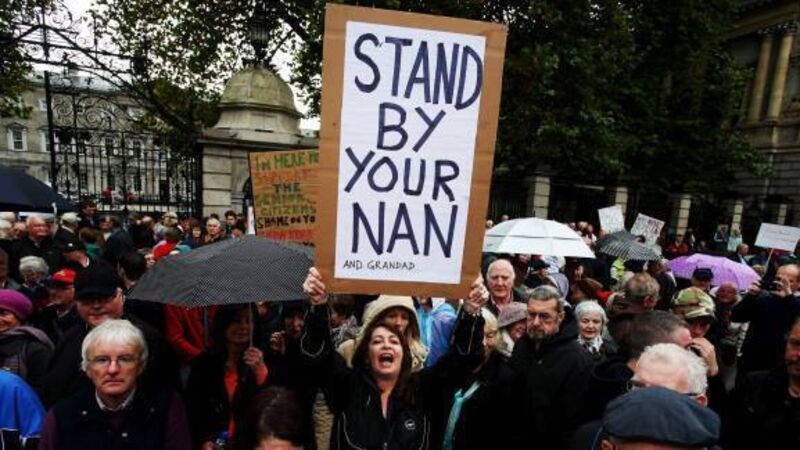No country for old women as females bear brunt of pension cuts

FOR most women retiring this year, they began working under the restrictions of the archaic marriage bar.
The bar meant women in the public service were legally obliged to quit their jobs as soon as they got married.
Even when this was lifted in 1973, women continued to work under the cultural expectation that when children came along it was their responsibility to stay at home.
There was no proper childcare structure in the country. Even today, the cost of pre-school care, and traditional gender hang ups, mean that more women than men are likely to be in part-time employment or have taken extended breaks in employment to be at home.
That is why internal statistics show that women, typically, have contributed less towards the social insurance (PRSI) scheme throughout their careers.
This gender disparity was clear in analysis done in 2011 before Social Protection Minister Joan Burton introduced a new payment structure of aligning the contributory pensions with the average number of weeks a person worked.
A comprehensive sample of files informed the creation of five new categories of weekly payment that are linked to the average number of PRSI contributions.
These categories cover those who put in, on average, less than 48 weeks of contributions a year during their working lives.
Details of this analysis were released by the Department of Social Protection to the Irish Examiner. There is a clear gender divide.
Women make up more than 60% of the people with less than 30 weeks of contributions. Men make up well in excess of 60% of those who contributed between 30 and 48 weeks worth of contributions.
However, women were in the majority in each of the three respective categories hit by reductions worth more than €1,100.
Where men were in the majority, one category had a €977 annual cut and the other had nothing taken.
This was not news to the Department of Social Protection.
The documents show that the impact on the lower categories, where there was mostly women, was flagged by officials in October 2011. As a result, the cuts were originally supposed to be worse than those implemented.
Internal pre-budget proposals were for cuts of between €53.08 and €57.63 for the three categories where there were predominantly women.
However, this was changed by the statistical study on a “good representative sample” of 5,476 contributory pension awards in September, October, and November 2010.
When the results of this sample was circulated, an email distributed among those planning the change one official commented: “What is noticeable is the numbers qualifying for the 98% rate with 20-29 (contributions) — these are going to be fairly significantly hit by the (measure).”
A further analysis was sought that broke down the proposed changes by gender. The figures were stark. They revealed that in the three lowest bands, where the cuts were heaviest, the proportion of women was between 60% and 64%.
In contrast, there was only 36% and 16% of women, respectively, in the two categories experiencing the least cuts. Reductions went ahead with people taking hits of more than €21 a week. The full effect of the changes has only started to emerge.
The way it was introduced meant that in 2012, 1,117 people suffered. This rose to 5,421 last year and 9,725 will feel it in 2014. However, next year, the number will jump to 14,029.
The number-one rationale behind the change, according to notes prepared for Ms Burton, was “the need to generate savings”.
But planners also wanted to underscore the link between the number of PRSI contributions a person makes and the State pension they receive.
On a number of instances, the internal documents pointed to the fact that any potential inequality was intended to be offset by a new measure Ms Burton approved — this was the homemaker credit.
It was designed to “put people who take time out of the workforce for caring purposes on a more equitable footing to those who are unemployed or sick and receiving a credit”.
The plan, signed off on by the minister, was to be backdated to 1994.
A note, dated March 9, 2012, said all that was required was agreement from Finance Minister Michael Noonan. “The Department of Finance is currently considering the department’s request for sanction to implement the homemaker credit and have raised a number of queries in relation to proposed timing and cost,” it said.
The homemaker credit has still not got the go-ahead and in a statement the department said the money has not been there for it.
“The possibility of introducing such a credit was given active consideration, but all such proposals are subject to very significant budget constraints, and it has not been possible to date to introduce such a change,” it said.
The department said the fact that more women had been working since 1994, and would benefit from the credit, it had suggested a significant if unquantifiable price.
“It is not possible to give a definitive cost of introducing such a scheme, as it would be covered by EU regulations and would therefore be open to Irish-born pensioners who emigrated to the UK.
“Any changes to the homemaker’s scheme which could result in further costs for the exchequer could only be considered in a budgetary context.
“Trends in terms of the existing homemaker’s disregards already point to an increase and the 20% increase in employment trends (with increased female employment rates) from 1994 to 2008 point to a likely significant increase in cost,” it said.
The documents show that the reaction to the measures introduced by Ms Burton was stronger in private than in public.
Once they were announced in December 2011, there was a kick from the trade unions.
Siptu president Jack O’Connor immediately wrote to Ms Burton.
“Quite frankly, I am shocked that such a penal measure could be contemplated by a Labour Party minister,” said Mr O’Connor.
“This measure disenfranchises vulnerable workers who have actually paid for this benefit through their social insurance contributions. Consequently, it contravenes a firm undertaking given by the [Labour] Party that rates would not be cut.”
David Begg, general secretary of ICTU, told the department it was a “a grossly inequitable cut which targets a section of the workforce and will adversely affect vulnerable workers, particularly women”.
In a subsequent letter, in January 2013, he reiterated his view that “the eligibility criteria to achieve the maximum payment are particularly unfair to women, many of whom have been out of the workforce for a period when their children are young”.
As part of a comprehensive statement issued last week, the department said, despite Mr O’Connor’s views, it had protected pension entitlements in general: “The minster has protected, as much as is possible, the primary rate of the State pension contributory in the context of the need for a massive fiscal adjustment... Despite the very significant reductions in expenditure required, it has been possible to defend this payment to a very significant extent, and the core rates have been protected, and not reduced.”
It also said that when the full experience of the contributory pension is taken into account, women typically get better value for the PRSI points they do contribute than men do.
This side-steps the fact that the time women spent at home as the de facto childcare system, which the State did not invest in, is not fully recognised.
“In relation to women (who are usually the main beneficiary of the homemakers scheme) and social insurance payments, it is worth noting that the recently published Actuarial Review of the Social Insurance Fund confirms that the fund provides better value to female rather than male contributors.
“It further confirms that those with lower earnings and those with shorter contribution histories, mostly women, have and will continue to obtain the best value for money from the fund due to the distributive nature of the fund,” the department said.
Cuts according to weeks per year of contributions to PRSI, averaged out over a working life-time
10-14 weeks (64% women). Annual cut: €1,196
15-19 weeks (63% women). Annual cut: €1,180
20-29 weeks (60% women). Annual cut: €1,497
30-39 weeks (36% women). Annual cut: €977.60
40-47 weeks (16% women). Annual cut: €0















